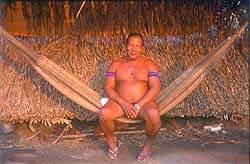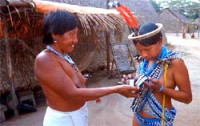
Photo.
An Indian resting - living in the Amazon -
Brazilian side (Per Henriksen, Reiseliv - www.Reiseliv.no - one of our freelance
journalists and an great adventurer from Norway).
It is estimated that the original
Indian population of
Brazil
ranged from 2 to 5 million at the time of first contact with Europeans in the
early sixteenth century. It is also estimated that 1200 languages were spoken in
Brazil at
that time. Because of violence and diseases, the original Indian population
become reduced to about 150,000 by the early twentieth century. Despite the
difficulties it faced, the Indian population began to recover its numbers and
increased to 330,000 by the mid-1990s.
The risk for extinction still threatens some
groups in Brazil. According to the
Norwegian national newspaper Aftenposten (4 March 2004),
the authorities in Brazil
expect that 42 native languages will be endangered if not the teaching in native
languages continues. FUNAI (National Foundation of the Indian) in
Brazil is in
charge of the teaching Indians so they can learn their own language properly. It
lives three Indians who speak different languages. When they die, their
languages also vanish.
Vanishing of
native language could be explained by many factors. The best known and largest
of the Indigenous areas is the 9.6-million-hectare Yanomami
Indigenous Park, located in
the northern states of Amazonas and Roraima, along
Brazil's
border with Venezuela.
Gold miners and their diseases have had an adverse impact on the Yanomami.
The Caiapó in
southeastern Pará became widely known both for their traditional environmental
management and their controversial concessions to gold miners and lumber
companies. Other indigenous areas include the Xingu
Indigenous Park and other
parts of Amazônia, including the western section of the Amazon along the Rio
Solimões, Roraima, northern Amazonas, Rondônia, Acre, Amapá, and northern and
southeastern Pará. The Northeast (Maranhão) and Center-West (western Mato
Grosso, Mato Grosso do Sul, and Goiás) regions also have large indigenous areas.
Rights and
conflicts
Diverse ethnic
and racial groups have been given right participating politically. Even thought
they are not represented in government and politics in proportion to their
numbers in the general population. Indigenous leaders and activists complain
that indigenous peoples have only limited participation in decisions taken by
the Government affecting their land, cultures, traditions, and allocation of
national resources.
|
Photo. Colourful Indians in the Amazon -
Brazilian side (Per Henriksen, Reiseliv - www.Reiseliv.no - one of our freelance
journalists and an great adventurer from Norway). |
 |
They also
criticized the Government for devoting insufficient resources for health care,
other basic services, and protection of indigenous reserves from non-Indians.
Illegal mining, logging, and ranching are serious problems on Indian land. Due
partly to the Government's failure to provide adequate medical care as required
by law, indigenous people have suffered epidemics of malaria, measles, and
tuberculosis.
According to the
chief of FUNAI (National Foundation of the Indian), FUNAI's medical department,
60 percent of the indigenous population suffers from a chronic disease such as
tuberculosis, malaria, or hepatitis. In certain areas of the Amazon region, up
to 80 percent of the population are affected. Illegal mining in the Amazon has
led to the doubling of the incidence of malaria in the period 1994-98. FUNAI
estimates that 75 percent of the affected population is indigenous.
The infant
mortality rate among the Yanomami in 1997 was 13 percent, while infant mortality
among non-Indian residents was only 1.5 percent. According to health workers'
unions, poor working conditions and lack of resources from the Government make
it very difficult for health workers to travel into indigenous areas to provide
sufficient medical care. Although racial discrimination has been illegal since
1951, darker skinned citizens say that they frequently encounter discrimination.
Demonstrations
The Amazon's Indian wars, was recently the
headlines in the newspaper Economist (www.economist.com).
The newspaper reports about a battle over an Indian reservation encapsulate the
arguments over whether and how to develop the Amazon. The Amazonian state of
Roraima has a whiff of impending civil strife.
Early in January
(2004) Indians from an reservation blocked roads leading to Boa Vista, the
state's capital, and occupied the offices of the agencies for federal agrarian
reform and Indian affairs. The dispute has not only polarised Roraima. It also
sheds light on wider struggles between environmentalists and enthusiasts for
traditional culture on one side, and advocates of economic growth on the other.
Brazil is
widely covered by Indian reservations. These are often vast tracts containing
few people but abundant resources, from wood to gold to water. The land and what
lies beneath it belong to the federal government, but the Indians control access
and economic activity. Most outsiders who care about such things consider this
fair. According to the Economist, reservations look like bulwarks against forces
that might imperil both the Amazon, where the biggest ones are, and the rights
of a weak minority. This view has powerful supporters, such as international
NGOs and Brazil's
Catholic Church.
The key for
the indigenous Indianans to get influence in the modern society is to learn to
read and write. In addition they need to keep their own language, social and
cultural identity.
Stein Morten Lund, 8
March 2004
Additional
information
Read more about
uncontacted Indians in the Amazon jungle on the Socio-Environmental Institute
website:
www.socioambiental.org
Instituto
Socioambiental (ISA) is a private institution, qualified as Organização da
Sociedade Civil de Interesse Público (Oscip), since 21 September 2001,
established to propose integrated solutions to social and environmental issues.
ISA's main objective is to defend the social good and rights, both collective
and diffuse, relating to the environment, cultural heritage, human rights and
the peoples.
To keep update with the Indians fight for their
rights, read The Economist newspaper: www.economist.com
